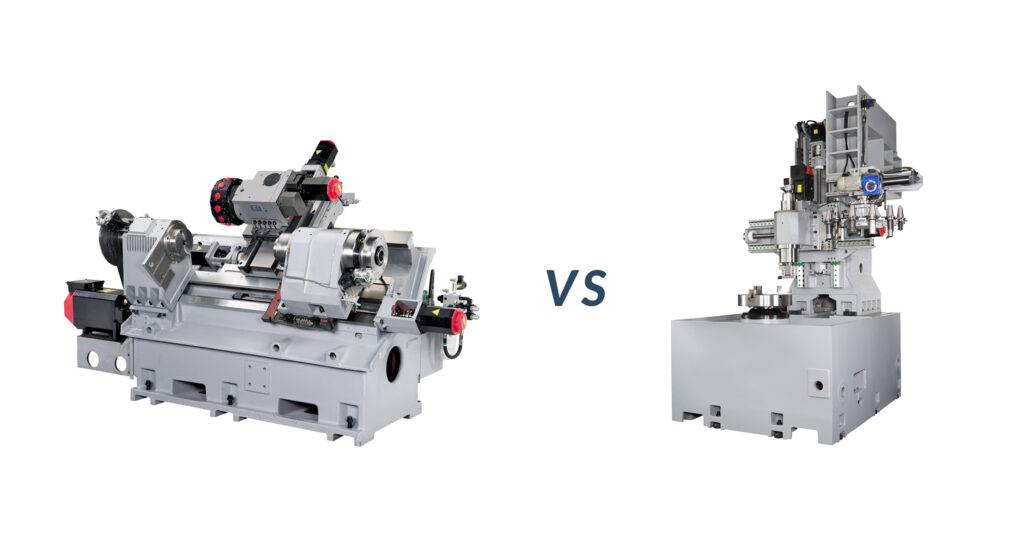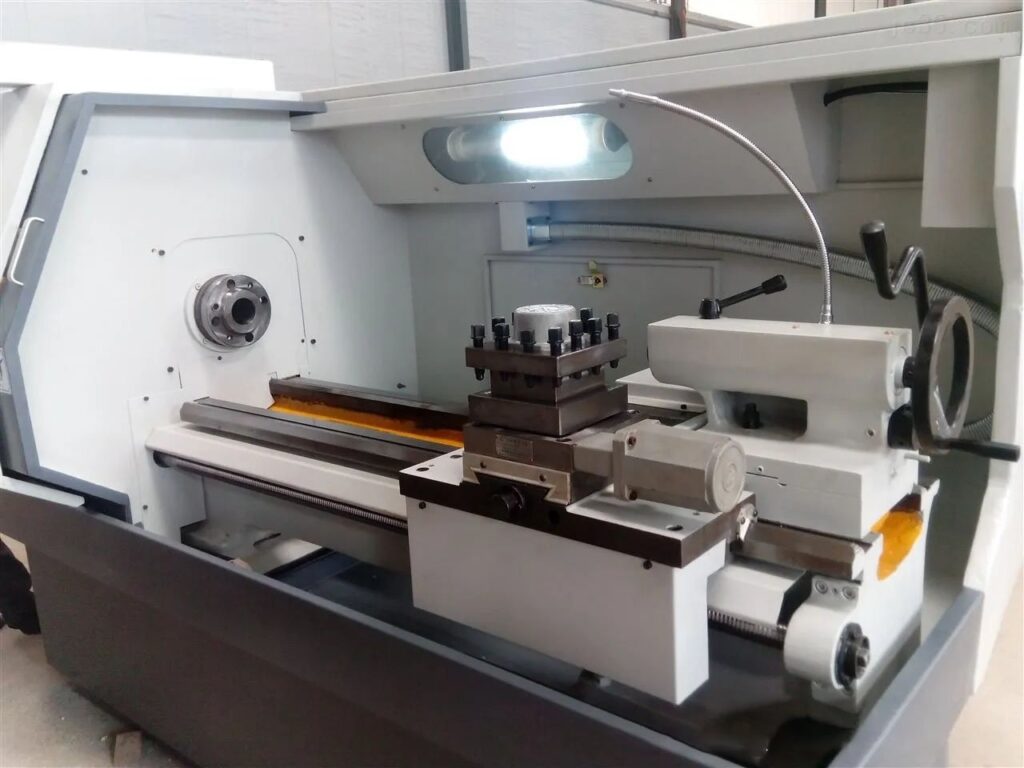A CNC lathe is a computer numerically controlled machine that uses a computer to make materials into cylindrical shapes with high precision. Unlike manual lathes, CNC machines operate with automated accuracy leading to the production of high-quality parts repeatedly. This makes it an important tool in modern manufacturing.
For example, you can transform your manual lathe into a precision CNC machine with our versatile CNC-ready lathe.
Critical elements in a CNC lathe consist:
- Spindle: This central rotating portion holds and turns the workpiece.
- Turret: It is where different cutting tools are kept for various machining operations.
- Chuck: This device clamps and holds the workpiece firmly during machining.
- Tailstock: Supports and stabilizes the material from one end.
- Bed: Is the base of the machine which contains other parts and absorbs vibrations.
- Headstock: It drives the machine as it has got a spindle and gearbox inside it.
- Guideway: These are rails on which moving parts move for precision movement.
- Tool holder: This part grips cutting tools tightly such that they cannot loosen up or fly out when working.
The operation of a CNC lathe involves holding the object in a chuck, turning it along with a spindle, and utilizing turret-mounted tools to cut away excess materials. Cooling systems manage heat & friction within this process. The cycle continues until the desired shape is achieved.
Fundamentally, a CNC lathe is an advanced instrument that marries mechanical dexterity with digital direction.
For Example, our tabletop lathe system is compact and powerful and ideal for hobbyists and small-scale production.
CNC Lathe Applications
The CNC lathe is a technological marvel that has become an indispensable investment for many different sectors. There is hardly a more adaptable machine, capable of producing both minute and intricate parts.
The Versatility of CNC Lathe
The ability to precisely form and shape materials into cylindrical forms of exceptional accuracy by the CNC lathe allows it to be used in various applications. It has been applied in the automotive industry as well as the aerospace, medical, and energy sectors.
CNC Lathe in the Automotive Industry
CNC lathe technology serves a large portion of the automotive industry. The precision required in modern vehicles necessitates machines that can manufacture components with very tight tolerances.
- Engine components: At its core, every vehicle contains an engine whose intricate components are made with CNC lathes. These machines shape crankshafts, camshafts, pistons, and connecting rods with accuracy. The designs are complex and dimensions precise; therefore, they require computerized numerical control lathes.
- Chassis and suspension parts: Vehicle chassis and suspensions must have strong parts that can withstand heavy loads yet perform at their peak levels.
CNC Lathe in the Aerospace Industry
The aerospace sector is another name for precision engineering where a CNC lathe has become one of its foundations due to multiple reasons. Flight demands endangering light and yet resilient components.
Aircraft components
Different parts of an aircraft such as landing gear and sleek fuselage are made using CNC metal lathe. The machine has to make intricate designs with high tolerances to ensure these structures remain structurally sound and aerodynamically efficient.
Precision parts for rockets and satellites
Technological advances in space exploration are at the forefront of the engineering revolution, a process that is taken forward by CNC lathes. Satellite parts, and rocket nozzles among other critical components must be extremely accurate and durable. This mode of mechanical fabrication also satisfies the requirements needed in the exploration of space.
CNC Lathe in the Medical Industry
Precise measurements, sterilization processes, and minimizing risks to patients’ lives are prioritized by the medical field. It is in meeting such requirements where computer numerical control (CNC) lathes excel best.
Production of medical implants
The accuracy and compatibility with body tissues of medical implants determine the quality of life of many people. Hip and knee replacements, dental bridges, and orthopaedic screws can be manufactured using CNC lathes with great precision. These implants’ success depends on the CNC lathe machine programming ability to produce complex shapes duplicating natural bone structure.
Surgical instruments
Fine operations performed by surgeons depend on highly precise instruments. Surgical equipment with the required accuracy and durability is produced by CNC lathes. It is necessary to create a variety of shapes for these tools, such as having sharp edges and smooth surfaces.
Dental equipment
Maintaining oral health contributes to overall well-being; this is one area where CNC has a part to play. Such dental equipment as drills, implant parts, etc., needs exact manufacturing. In this context, they apply efficiency and a high level of accuracy which are characteristics inherent in these machines.
CNC Lathe in the Energy Industry
The energy sector relies heavily on strong, efficient equipment regardless of whether it is renewable or traditional energy-focused. This vital industry uses CNC lathes to make components.
For Example, Build your own CNC lathe from scratch with our easy-to-follow instructions and high-quality components. Build your own CNC lathe from scratch with our easy-to-follow instructions and high-quality components.
- Components for power plants: Whatever fuel source powers them – fossil fuels, nuclear energy, or renewables – power plants have numerous components in their composition. Turbine blades, and pump shafts among other crucial parts are produced through the application of CNC lathes.
- Oil and gas industry applications: Oil drilling occurs in harsh conditions that require special machinery designed for particular situations. Valves, pipes, etc., used in oil industries are made using these machines called CNC lathes.
CNC lathe technology has become an indispensable asset in modern manufacturing.
Drive Systems and Control

Lathe motions are driven by servo and stepper motors. Encoders give accurate information regarding position for precise control.
CNC Lathe Considerations
The performance of a CNC lathe is highly influenced by several factors. It is vital to attain high accuracy, precision and repeatability while producing parts according to the exact specifications. The cost-effectiveness and return on investment (ROI) of these machines are also considered by organizations.
Efficiency and productivity are equally important to ensure timely production. Moreover, the cost-effectiveness of the machine and its return on investment (ROI) are key considerations for businesses.
Maintenance and Troubleshooting
A consistent maintenance schedule ensures that it maintains optimal performance leading to a prolonged lifespan. Such activities as cleaning, lubrication, and inspection should be done regularly. At the same time, the ability to detect tool wear, lack of dimensional accuracy or vibration is immensely critical in uninterrupted operation.
Safety Considerations
In any CNC lathe operation, safety should be given priority. Using appropriate protective equipment as well as observing safety practices will help prevent accidents or injuries at workplaces. This way companies can optimize their CNC lathes by taking these factors into account thus maximizing their efficiency.VTI machining is a specialized technique often employed in conjunction with CNC turning to achieve exceptional surface finishes and dimensional accuracy.
Various Types of CNC Lathes
CNC lathes come in different forms depending on the required production volume.
Horizontal vs. Vertical Lathes

The orientation is the main difference between a lathe and a mill.
There are horizontal lathes, which are the most common type where the workpiece rotates horizontally on a bed; they are versatile and can be used for a variety of parts. Lathe operators must adhere to strict safety protocols to prevent accidents and injuries.
Vertical lathes are designed primarily to handle very large, heavy workpieces that cannot be carried by horizontal machines easily because of their vertical spindle.
For example, Boost productivity and reduce setup time with our CNC lathe featuring an automatic tool changer.
Slant Bed vs. Flat Bed Lathes

In horizontal lathes there are two main bed configurations:
Slant bed lathes have beds inclined at an angle to enhance chip removal and rigidity; they are commonly chosen for high precision and high-speed machining.
Flatbed or straight bed lathes have a level plane about the ground and may be more economical but may not chip away as well as slant beds or have quite the same strength as them.
Multi-Axis Lathes

These machines have additional axes beyond standard X, Z, and C axes (spindle rotation).
This feature enables simultaneous machining of multiple surfaces hence lowering setup time and improving part accuracy.
Therefore, multi-axis lathes serve a vital role in producing intricate components with undercuts; holes, or complex contours.
Swiss Type Lathes

Swiss-type lathe built specially for accurate machining of small parts has some unique features:
They use guide bushing which provides extremely rigid and precise support for the component being machined on it.
Example for precision metalworking made easy with our durable and reliable metal CNC lathe machine.
Such turning equipment is often utilized in the medical industry where long thread-like products with intricate profile geometries appear frequently together with automotive applications such as fuel injection nozzles or electronic industry involving connectors used in mobile devices like cell phones among others.
Multi-Spindle Lathes

For large-scale production, multi-spindle lathes have notable productivity advantages:
They have multiple spindles such that several parts of a workpiece can be machined at once or different parts all at the same time.
Thus, this configuration reduces cycle times and increases outputs.
Typically, multi-spindle lathes are used in mass production industries like automotive as well as hardware making.
CNC Lathe Milling Machining Services
GY Machining has professional lathe operators to mill CNC parts on best lathe machines. From CNC lathe machine programming, to CNC turning programming, our turning centers can machine CNC parts with tight tolerance.
FAQs
What is a CNC lathe?
A CNC lathe is a computer-controlled machine tool used to shape materials by rotating them against a cutting tool. It offers high precision, efficiency, and repeatability compared to manual lathes.
What is the difference between a CNC and a normal lathe?
The primary difference lies in control. A CNC lathe is operated by a computer program, allowing for complex shapes and high accuracy. A normal lathe is manually operated by a skilled machinist.
Is CNC machining easy?
While the machines are advanced, operating a CNC lathe requires specialized knowledge and training. Programming the machine can be complex, but modern software has made it more user-friendly.



